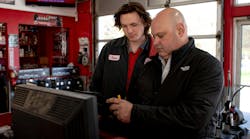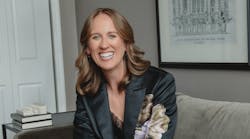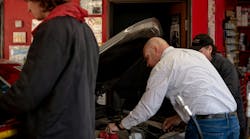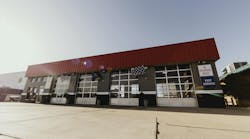I have been conducting an ongoing research project for myself hoping to discover what our industry is going to look like over the next few years. As a former operation manager for a chain of quick lubes, one of my duties was to try to forecast what the future would look like. If I was successful in my prediction, then the company would benefit from the forecast; unfortunately, when I was wrong, the company would miss out on some opportunities. Trying to predict the customer was always the most complicated, but just because it was complicated didn’t mean I didn’t try. Our industry has developed multiple ways to operate. The two most prevalent methods are the traditional quick oil and lube and the oil change-plus — or those one-stop shops. Both methods have proven to be successful ways to operate, and both have their merits.
During my research, I was given several opportunities to discuss these new normal ideas, and when National Oil and Lube News published the annual Fast Lube Operator Survey in September and the new Oil Change-Plus Operator Survey in November, I was able to prove a lot of the research based on what operators were saying around the country. With all of the operational differences in the industry, the customer remains the same. Last month, this space discussed the customer profile. If you are interested, you can go online to noln.net and refresh your memory about the customer profile. This month will focus on customer expectations. The research I did is mine and, of course, is also my opinion, based on conversations with operators, suppliers, manufacturers and different publications I have read during the last few months.
What are the Customer’s Expectations?
Customers expect you to be an expert! Everyone agrees today’s vehicles have become technically sophisticated. In the past, the owners manual would have sections on how to service various components on our vehicles. In some cases, vehicle manufacturers would include a user-friendly toolbox to assist you in performing different maintenance requirements on the vehicles. The original equipment manufacturer (OEM) designed and built a vehicle that was user friendly with the expectation that the owner would perform their own maintenance. We have a category for these folks — do-it-yourselfer or DIY.
Those of us who were around the industry a couple decades ago remember when ad campaigns targeted this segment of society because it was such a large group of people. This is not the case anymore.
Most owners manuals today only suggest returning to the dealership for needed services, and the DIYers are mostly gearheads who would never consider taking their cars to a shop. Because of this and other circumstances, the buying public expects you to be an expert.
An interesting perception the buying customer has is if a company has gone to the expense of constructing a building and equipping it with the tools to work on these sophisticated vehicles, then the employees must be experts. Why else would the shop owner go to the expense if they don’t have experts working on the vehicles? Technicians on the front line will tell you educating a customer is not a gender issue or a generational issue, because every part of our society suffers from vehicle illiteracy. Even retired mechanics will confess today’s vehicles are complicated and say if they were starting over, they might consider another line of work.
In the past, our public schools used to offer vocational car repair classes for those who wanted to pursue a career in automotive repair. Now, entire institutions have been developed that spend millions of dollars on curriculum and classrooms to teach today’s technicians how to diagnose and repair a vehicle. It is no wonder the driving public’s first expectation for your shops is that your staff is full of experts in servicing vehicles. An interesting tidbit is not only do our customers expect us to be experts, but they also assume we are. It is only when we prove we are not experts the customer is disappointed.
More Customer Expectations
Additional services have become as much a part of our industry as changing the oil and filter. According to the 2014 NOLN Operator Survey, our customers have proven if we offer the products and the services, they would prefer to buy them from us. Professionalism and training is the key to success in performing these services. Shops that have an aggressive training schedule help ensure the service is performed correctly. Good training also gives your techs the ability, confidence and professionalism that your customers expect. Many of the part manufacturers, as well as suppliers and distribution centers, are recognizing the need for training programs. Most franchises have revamped or renewed their training procedures and guidelines. If you are not aggressively pursuing a continued training program, then quite frankly, you are missing the boat.
Talk to your suppliers, warehouses or franchisors and ask what is available. If none of these organizations can help, consider the Automotive Oil Change Association (AOCA).
AOCA has recently updated several of its manager and technician training courses to address this critical component in our industry. AOCA enlisted several industry leaders to guide them in a renewed training for shops.
According to the 2014 NOLN Operator Survey, in almost every category of services offered, consumers purchased more services in 2014 from our industry then in the past three years. Filters — including air filters, cabin filters, fuel filters and transmission filters — are still the most requested services from our customers. Light bulb replacement has increased 16 percent in the last three years. Light bulbs are a great example of what used to be an easy fix normally performed by the customer, but now show how complicated our vehicles have become. Thanks to the government requirements (CAFE standards) on fuel efficiency, fuel-related services have grown to new levels. These include everything from pour-in-the-tank products to more enhanced fuel system analyzing services. Tire services, such as rotations and balancing, have increased over three times in the last few years, with many indicators suggesting this trend will continue to grow.
As our vehicles continue to become more complicated, so will our customer base. The new normal for our customers will be a level of expectation we have not seen before. The shops that recognize this trend and react to it will also be able to have higher expectations for themselves.
If you want to capitalize on this opportunity, a good place to start training yourself and your staff is this year’s iFLEX convention in Orlando, Florida. When you are at the convention, stop by and say, “Hi” to the NOLN staffers on the convention floor or come to the breakout session I will be moderating on the discussion of quick lubes versus oil change-plus shops. I would enjoy the opportunity to visit with you.
Next month we will discuss employee expectations, and like the rest of the new normal, they have also changed.
RAGAN HOLT is the quick lube advisor for National Oil & Lube News. He is available for consulting and training in the quick oil and lube industry. He can be contacted at: [email protected]





